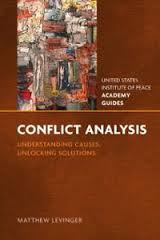|
Reviewed by Benjamin Arah, Associate Professor of Government & Philosophy, Department of History & Government, Bowie State University Conflict Analysis, by Levinger (2013), is an extraordinary and comprehensive easy-to-read guide book for stakeholders interested in diplomacy, humanitarianism, and how to deal with and resolve conflict by working to build a lasting peace. As the subtitle suggests, this handbook is brilliantly written to integrate theory with practice for diplomats, peace professionals, and political leaders to have a critical understanding of the causes of conflicts in order to unlock the solutions. In writing the book, Levinger expressed his desire to introduce the practitioners to different analytical tools that are resourceful in identifying emerging threats and have the needed skill-set with which to manage or resolve conflicts. Added to this is the author’s wish “to give nonspecialists an understanding of the potential trajectories of a conflict situation so they can develop effective peacebuilding strategies” (Levinger 2013). Levinger’s Conflict Analysis has a brief Introduction (pp. 1-7), nine (9) chapters, a conclusion and the appendices for a total of 268 pages. The book has three parts: “Understanding Deadly Conflict” (chapters 1, 2, and 3); “Tools for the Trade” (Chapters 4, 5, 6, and 7); and “From Analysis to Action” (Chapters 8 and 9). In the Introduction, Levinger describes conflict as a social necessity inherent in human biology, saying that conflict is a central and enduring feature of existence which, like death, is equally inevitable. He notes that conflict “occurs whenever two or more individuals or groups perceive their interests as mutually incompatible and act on the basis of this perception” (2013). Humanity approaches and deals with conflict “violently, as in a war, or nonviolently, as in an election or an adversarial legal process” which “when channeled constructively, conflict can be beneficial” (p. 1). It is not that people cannot avoid conflicts, for conflicts are inevitable, so long as human beings are aggressive and inherently competitive in their quest for the good life. Because “peaceful competition can inspire the pursuit of excellence and lead to great economic, cultural and political achievements” (Levinger, 2013), it becomes imperative to understand conflicts in order to learn how to unlock their strategic solutions in an attempt to achieve peace. I found Chapter One to be fascinating and resourceful. In it, Levinger discusses “Global Conflict in the 21st Century” (pp. 11-28) by highlighting the vagaries of conflict which could be violent, deadly and costly to the detriment of everyone involved. All conflicts are costly and, at times, even deadly with pan-cosmic and tragic consequences. Put simply “deadly conflict imposes steep economic and human costs, the effects of which persist long after the conflict ends” and “many of these effects spill across borders into neighboring countries and in some cases have profound global reverberations” (Levinger, 2013). Levinger writes with remarkable simplicity and brevity, and his Conflict Analysis will certainly have a significant impact on the field due to his profound ability for clarity of thought and economy of language. In concluding Chapter One, Levinger discusses “Conflict Analysis and Adaptive Leadership” (pp. 19-27). He notes that some countries, governments, and non-governmental and international organizations have taken steps to make conflict analysis and prevention central elements of their mission. Levinger recounts what happened in Rwanda, Burundi, and Somalia to argue that “skills in conflict analysis and adaptive leadership are essential not only for high-level officials such as the UN Chiefs of mission, but also for practitioners working at the local level in conflict zones” (2013, p. 25). He reasons that violence is a “flawed” or non-rational strategic human choice that could be avoided, if parties understand the nature of conflicts and “start to discover openings for cooperative resolution of their disputes” (p. 56). Warren Bennis, in his “Forward” to Resolving Conflicts at Work: Ten Strategies for Everyone on the Job (2011), by Kenneth Cloke & Joan Goldsmith, saw conflict as an opportunity for leadership. He wrote that “we are in dire need of leaders who can courageously confront and resolve the many conflicts that plague our organizations and threaten our well-being, who can address and resolve the conflicts that damage the very fabric of society, and who can openly and skillfully resolve conflicts that have an adverse impact on our daily lives” (p. vii). Human beings living in political communities and with different perspectives will always have conflicts, but we need to avail ourselves of the analytical tools that Levinger provides in his book to learn how to deal with and solve conflicts. |


 Conflict Analysis: Understanding Causes, Unlocking Solutions
Conflict Analysis: Understanding Causes, Unlocking Solutions